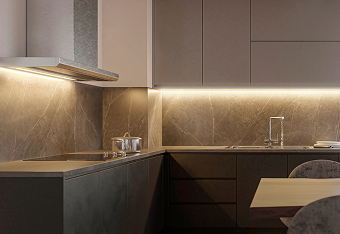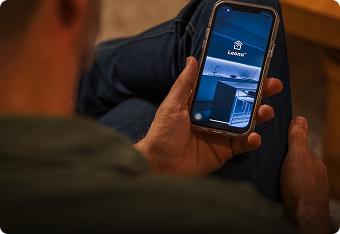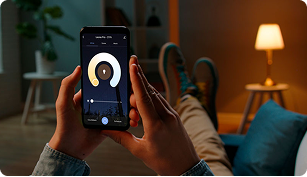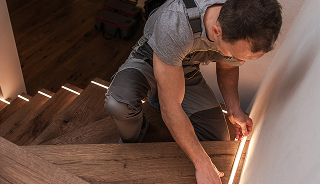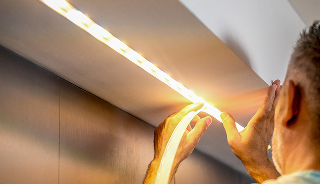Cove Lighting with LED Strip Lights
If you’re thinking about installing LED cove lighting in your home or business, you’ve come to the right place. Whether this is your first time or you need a refresher, we’ll carefully take you through every step of the process to make it as effortless as possible.
From learning how to choose the best LED strip light for cove lighting to picking out power supplies, we’ve created an easy-to-follow guide on how to install LED cove lighting at home.
If you already know which color temperature, LED strip and voltage option you want, you can skip down to step two. If you still need help deciding, continue down below to step one.
What is Cove Lighting?
Cove lighting is a basic indirect lighting technique that creates diffused lighting to illuminate a space. Indirect lighting or ambient lighting hides the light source from view while the light reflects off of other surfaces to provide a soft, even distribution of light.
These days, construction professionals, designers, and architects agree that LED strips are the best lights for cove lighting because it’s a way to fine-tune a classic technique with a modern feel. Made with the latest technology, LED strips provide beautiful lines of light that mimic the allure of natural light without the harsh glare of outdated fixtures.
Like any other trend, cove lighting design is constantly evolving to keep up with modern times. If you have fluorescent or incandescent lighting fixtures (or no lighting at all), this is the time to learn about beautiful LED cove lighting.
Not only are LED strips extremely flexible, but they’re also very easy to install on your own. You can peel and stick the strips wherever you please and even cut them to any specific length with no major tools. LED cove lighting DIY has never been easier.
5 Simple Steps on Installing LED Cove Lighting
1. Choosing the Best LED Strip Light for Cove Lighting
A. How to Choose Brightness for Cove Lighting
B. How to Choose Color Temperature for Cove Lighting
C. Best LED Strip Lights for Cove Lighting
D. Best Voltage Option for Cove Lighting
E. Where to Install (Placement)
2. Choosing Your Control System
3. Choosing Your Power Supply
4. Solderless Connectors and Wires
5. Mounting and Extrusions
Design Support (Free project design included)
1. Choose the Best LED Strip Light for Cove Lighting
Multiple factors come into play when choosing the best LED strip light for cove lighting.
- How big is your cove?
- What is the purpose of the lights - will it be the main source of lighting or do you want to create a particular atmosphere?
- What color temperature do you prefer?
- Where will you install?
- Do you want a static white output or a color changing or Dynamic Tunable White output?
- How do you want to control your lights?
- Are you looking for something temporary or prefer a long-lasting permanent fixture?
To help you narrow down the best options, we’ve created a short checklist to help you on the first steps on figuring out LED cove lighting details. If you already know which strip you need for your project, skip ahead to step two to choose your control system.
A. How to Choose the Appropriate Brightness Levels
What level of brightness are you seeking? Brightness is measured in lumens, so the higher the lumen output, the brighter the light. LED cove lighting can be broken up into three main types of lighting based on the goal you want to achieve. Lumen needs may vary from project to project depending on the size of the coves and the height from the floor to the cove. However, below is a general guide.
-
- Principle lighting will be the primary source of light and will call for brighter, higher-output strips.
The lumen output you are looking for should be between 400 - 1,000 lumen/ft. - Accent lighting is for aesthetic purposes that draws attention to a particular area, such as highlighting ceiling decor.
The lumen output you are looking for should be between 200 - 500 lumen/ft. - Mood lighting or mood lighting provides a soft, overall illumination that blankets the space.
The lumen output you are looking for should be between 100 - 300 lumen/ft.
- Principle lighting will be the primary source of light and will call for brighter, higher-output strips.
B. Choosing Color Temperature (CCT)
Next, is to decide which color temperature, or shade of white light, you prefer. Color temperature is measured in kelvins - the lower the temperature, the warmer the light.
To choose the best color for LED cove lighting, here are some questions to consider:
- Is there other lighting present in the room? If yes, you may want to match the CCT of that lighting.
- What type of atmosphere do you want to create? Warmer temperatures will help you relax and unwind while cooler temperatures will invoke focus and awareness.
- What kind of decor do you have? Choosing color temperature and interior design play mutually important roles to each other. If you have more of a contemporary look, lean into cooler temperatures. For vintage decor, warmer temperatures will work better.
- What area is the cove lighting installed?
- For bedrooms, TV rooms and rest areas, warmer color temperatures are preferred, allowing your body to unwind and mind to relax.
- In hallways, entryways and communal spaces of the home, a natural white color is most common.
- In kitchens, walk-in closets and storage areas, daylight or cool light is preferred.
Can’t decide on one? If you choose the Architectural Dynamic Tunable White Series, you can access countless temperatures at your fingertips by controlling the output of your strip to any of the colors above.
C. Choosing Voltage Options
Many LED strips come in a variety of DC voltage inputs. Most of our LED strip lights are offered in 12V, 24V and 48V DC input versions.
Choosing the best voltage option for your project can actually be very simple. One of the main deciding factors in choosing the voltage of your LED strip light has to do with voltage drop. Voltage drop is the gradual loss of voltage of energy in DC circuits as it flows through the strips of light, meaning you cannot install an infinite run of lights, and that you may get a loss of brightness at the end of a long run of DC input LED strips.
To avoid voltage drop, all of our LED strip lights have been rigorously tested to create the longest run length before a decrease in voltage. This means your strips will maintain their brightness up to the maximum run length.
Choosing voltage options depending on the size and type of your project. But let’s make it even easier for you to decide.
For LED cove lighting, the recommended choice is to purchase a 24V version, as coves tend to require medium sized run lengths for most cases. Additionally, all of our dimmers and remote controls are compatible with 24V versions.
D. Best LED Strip Lights for Cove Lighting
Now that you know what level of brightness you need, which color temperature you want, and the best voltage option, you’re ready to pick from our recommended strips for cove lighting. We have manufactured all of our strips with cove lighting in mind. The following four UltraBright™ strip lights offer similar color temperatures and all offer 24V options.
Additionally, these strips have excellent color rendering and come with a 15-year warranty, which is the longest in the lighting industry.
Best Static White Strip Light Options for LED Cove Lighting
Best RGB and Dynamic Tunable White Strip Light Options for Cove Lighting
Best LED Lighting Fixtures for Cove Lighting
E. Where to Install (Placement)
Depending on what type of cove you have, there are various ways to install LED cove lighting. The great thing about strip lights is that their flexibility gives you more freedom of placement. And the 3M adhesive backing makes installing LED strip lights on ceilings very easy, especially in narrow spaces.
You can add LED cove lighting to false ceilings, tray ceilings, crown moldings, ledges, wall depression, I-beam coffers, valences, or other types of dropped ceilings. They’ll all have similar effects though; the light from the strip will bounce off of neighboring surfaces, creating a beautiful diffusion of light to illuminate the cove.
The following diagram shows four main types of cove lighting to help you determine where to exactly install the strip lights.
2. Choosing Your Control System
All of our strip lights are fully dimmable. This means you can easily adjust brightness levels to perfect LED cove lighting details, allowing you to switch between bright principle lighting to warm ambient lighting.
To experience the full potential of our LED strip lights, dimmers are highly recommended in cove lighting. Dimmers will also help you save energy by preventing the lights from being on 100% brightness at all times.
If you use the Outline, Accent or Architectural Series, you can choose from these control systems:
- Lutron® Wall Dimmers - Convenient wall dimmers to control brightness levels with wireless features
- LED Smartphone Controller - Control brightness levels via Bluetooth from your smartphone
- Multi-Zone Remote & Receiver Combo - Advanced RF technology lets you program favorite settings on your controller
- Touch Series Dimmer - Using radio frequency, you can adjust your lights using a simple dimming wheel
- Wireless Wall/Desktop Dimmer and Receiver - Wireless wall-mounted dimmer that’s as easy to use as it is beautiful
If you want the Architectural Dynamic Tunable White Series, you can choose from these control systems
- LED Smartphone Controller - Control brightness and color temperatures via Bluetooth from your smartphone
- Wireless Wall/Desktop Dimmer and Receiver - Wireless wall-mounted dimmer that’s as easy to use as it is beautiful
- Touch RF Remote Controller - Choose your favorite color temperature with this remote using radio frequency
3. Choosing Your Power Supply
The type of LED power supply you need for your project depends on if and how you want to control your lights with a dimming system in your setup. The next step is to choose from our list of compatible power supplies and drivers to turn on your lights.
Quick guideline: If you’re using a Lutron® dimmer or any other AC wall dimmers, you need a Zurik® dimmable driver. You cannot use the Zurik driver with RGB or Dynamic Tunable White systems.
A. Choosing the appropriate style of power supply.
B. Calculating the size of the power supply you need
Check out this in-depth guide to choosing the correct power supply or refer to our power supply calculator chart for a detailed look on which power supply you need.
To calculate the size of the power supply for your LED strip light, you need to calculate the total watts used in your strip. Each strip consumed a different amount of watts per ft (W/ft). Take the w/ft and multiply it by the number of total feet you are hooking up to the power supply. Then, take that number and add an additional 20% to prevent overloading the power supply. It is better to under-load the power supply because it will help increase the lifespan by keeping it cooler.
4. Solderless Connectors and Wires
The best way to install cove lighting involves some simple handywork. Although soldering is the best way to make long-lasting connections, using solderless connectors to connect LED strips and power supplies is an easier and quicker method.
First, you need to cut your strip light to the desired length. All of our LED strip lights for cove lighting are manufactured with cut marks that are as frequent as every half inch to 4 inches for optimal customization. Using sharp scissors, you can easily cut your LED strip light to the desired length.
There are different types of connectors for single-color strips and dynamic tunable strips. Look below to select the proper connectors for your strip.
- Solderless Connectors for Accent, Outline and Architectural Series Strip Lights (Single-Color)
- Solderless Connectors for Dynamic Tunable White Series Strip Lights
If you want to try soldering and would like some guidance, please get additional help from a professional. Or contact our team of experts at (844) 353-9347 who can give you clear step-by-step instructions to make sure you complete the installation in a safe and efficient manner.
5. Mounting and Extrusions
How to Mount LED Strip Lights
All of our LED strip lights have 3M adhesive backing so mounting will be very easy. The 3M will stick to most non-porous and flat surfaces.
Make sure to thoroughly wipe down the installation area, then carefully peel back the protective cover over the strip’s adhesive backing. Run the strip in a straight line inside the cove.
Using Mounting Extrusions
In LED strip lighting, aluminum extrusions are used for aesthetic and functional benefits. They can conceal the strips from view and help diffuse the light into consistent linear lighting. If you are looking to mount the strip in a particular angle, you can select an extrusion to achieve that look. If the cove is very dirty, porus or not flat, extrusions will ensure that the flexible strip light is installed straight with no bends or hotspots. Extrusions can also work as heat sinks if you have a high-output strip.
However, using a full extrusion with a lens in cove lighting is not that common. LED strips are already usually hidden from view and the light reflecting off of the ceilings and walls will create beautifully-diffused lighting. A great option is just to use a piece of thin aluminum, we call the ION Extrusion, specifically for this project type.
Free Design Support
Whether you have a question or need general assistance, we’re here to help! Check out this section on installing LED strip lights at home for cove lighting DIY or contact us and get an answer within 24 hours.
Free Project Design
We offer free design support! That’s right, our team of lighting specialists and design experts will work with you one-on-one to create your dream project, no strings attached.
Chat
Chat with one of our lighting designers on the bottom right hand of the screen to get an expert consultation in minutes!
Call
Call us at (844) 353-9347 Monday through Friday 6AM - 4PM (PT).
Related Posts
5 Simple Steps on Installing LED Cove Lighting
1. Choosing the Best LED Strip Light for Cove Lighting
A. How to Choose Brightness for Cove Lighting
B. How to Choose Color Temperature for Cove Lighting
C. Best LED Strip Lights for Cove Lighting
D. Best Voltage Option for Cove Lighting
E. Where to Install (Placement)
2. Choosing Your Control System
3. Choosing Your Power Supply
4. Solderless Connectors and Wires
5. Mounting and Extrusions
Design Support (Free project design included)


